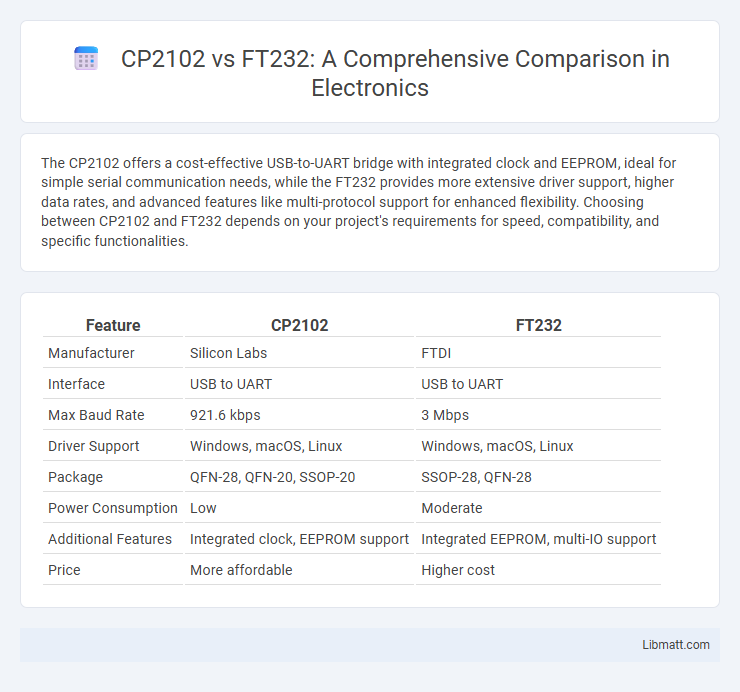The CP2102 offers a cost-effective USB-to-UART bridge with integrated clock and EEPROM, ideal for simple serial communication needs, while the FT232 provides more extensive driver support, higher data rates, and advanced features like multi-protocol support for enhanced flexibility. Choosing between CP2102 and FT232 depends on your project's requirements for speed, compatibility, and specific functionalities.
Table of Comparison
| Feature | CP2102 | FT232 |
|---|---|---|
| Manufacturer | Silicon Labs | FTDI |
| Interface | USB to UART | USB to UART |
| Max Baud Rate | 921.6 kbps | 3 Mbps |
| Driver Support | Windows, macOS, Linux | Windows, macOS, Linux |
| Package | QFN-28, QFN-20, SSOP-20 | SSOP-28, QFN-28 |
| Power Consumption | Low | Moderate |
| Additional Features | Integrated clock, EEPROM support | Integrated EEPROM, multi-IO support |
| Price | More affordable | Higher cost |
Introduction to USB-to-Serial Converters
USB-to-serial converters like the CP2102 and FT232 enable seamless communication between USB ports and serial devices by translating USB signals to UART or RS232 protocols. The CP2102, developed by Silicon Labs, offers integrated USB functionality and low power consumption, making it ideal for embedded systems. Your choice between CP2102 and FT232 depends on factors such as baud rate support, driver availability, and application requirements.
Overview of CP2102 and FT232 Chips
The CP2102 and FT232 are popular USB-to-UART bridge chips widely used for serial communication in embedded systems. The CP2102, developed by Silicon Labs, offers integrated USB transceivers and Baud rate generators with low power consumption and compact design suitable for cost-sensitive applications. The FT232 by FTDI features a reliable USB interface with robust driver support across multiple platforms and higher data transfer rates, often preferred for industrial and professional-grade applications.
Technical Specifications Comparison
The CP2102 offers up to 1 Mbps UART baud rate with integrated USB 2.0 full-speed interface and low power consumption, while the FT232 supports up to 3 Mbps UART baud rate, USB 2.0 full-speed, and features enhanced data buffering for higher throughput. In terms of package options, the CP2102 comes in compact QFN and QFP packages, contrasted by the FT232's SSOP package, which impacts your PCB design flexibility. Both chips provide built-in voltage regulators and EEPROM for custom configurations, but the FT232 includes additional features like asynchronous FIFO for improved data handling in complex applications.
Driver Support and Compatibility
The CP2102 USB to UART bridge offers extensive driver support across Windows, macOS, and Linux, ensuring seamless integration with a wide range of operating systems and devices. In contrast, the FT232 series from FTDI provides robust drivers with a strong emphasis on legacy support, particularly for older Windows versions and embedded systems. Both chips benefit from comprehensive virtual COM port drivers, but FT232 often has an edge in industrial applications due to its mature driver ecosystem and extended compatibility.
Data Transfer Speed and Reliability
The CP2102 chip offers data transfer speeds up to 1 Mbps through UART communication, making it suitable for standard serial applications with moderate speed requirements. The FT232, manufactured by FTDI, supports higher data rates up to 3 Mbps and is known for robust driver support and reliable USB-to-serial conversion. In terms of reliability, both chips provide stable communication, but the FT232 generally exhibits enhanced error handling and compatibility across various operating systems, ensuring consistent performance in demanding environments.
Power Consumption and Efficiency
The CP2102 USB-to-UART bridge offers lower power consumption compared to the FT232, making it more efficient for battery-powered applications. It typically operates at a current of around 12 mA during active data transmission, whereas the FT232 can consume up to 15 mA or higher. Your design benefits from the CP2102's optimized power efficiency, helping extend device battery life without sacrificing communication performance.
Hardware Design and Integration
The CP2102 offers a compact, integrated USB-to-UART bridge with a simple pinout and minimal external components, making hardware design straightforward and space-efficient. FT232 modules require additional components such as crystals and EEPROM for configuration, increasing PCB complexity and size. Your choice between CP2102 and FT232 impacts the ease of integration, with CP2102 often preferred for streamlined designs needing fewer parts and simpler layout.
Pricing and Availability
The CP2102 USB-to-UART bridge typically offers lower pricing and broader availability due to its widespread adoption in budget-friendly electronics and DIY projects. FT232 modules, while slightly more expensive, provide a stable supply with consistent quality, favored in professional and industrial applications. Both chips are widely supported, but CP2102's cost advantage makes it popular for mass production and hobbyist markets.
Applications and Use Cases
The CP2102 USB-to-UART bridge is widely used in embedded systems, IoT devices, and microcontroller programming due to its low power consumption and compact design, making it ideal for portable applications. The FT232 excels in industrial automation, GPS modules, and USB device development because of its robust driver support and versatile interface options. Your choice between CP2102 and FT232 depends on whether you prioritize cost-efficiency and simplicity or enhanced performance and compatibility in complex systems.
Conclusion: Choosing Between CP2102 and FT232
Choosing between CP2102 and FT232 depends on your project's specific requirements such as power consumption, driver availability, and cost. The CP2102 offers low power operation with broad OS support and a compact design, making it ideal for embedded systems and cost-sensitive applications. Your decision should weigh the FT232's mature driver ecosystem and reliability against CP2102's efficiency and affordability.
CP2102 vs FT232 Infographic

 libmatt.com
libmatt.com